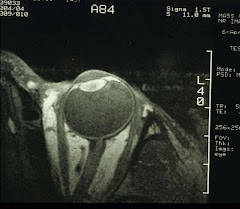Medical necessity simply means whatever is "reasonable and necessary for the diagnosis or treatment of illness, injury, or to improve the function of a malformed body member" - according to Medicare. So the double-lid surgery cited above does not qualify. Also excluded is the "bags under the eyes" which are simply too common to merit any especial attention. They are essentially pockets of fatty tissues which can be removed and the skin tightened with the basic Z-plasty. Some of course opt for the procedure to look younger. Sometimes, however, the "bags" are from accumulation of fluids, as part of a general fluid retention, then the underlying problem(s) should be addressed instead.
There are many medically necessary cosmetic surgeries for the eye/orbit, usually performed by specially-trained hospital-based plastic surgeons. To name a few: ptosis repair, excision of cancer of the lid-margins, orbital decompression for Graves' Disease, patching of fractured orbital bones, prosthetics implants, reconstruction of facial deformity, repair of tear drainage system, and pterygium removal. This list probably should alert you that not all plastic surgeons are trained or qualified to operate on the eye and orbit.
A few examples of the eye plastics are presented below:
The most common procedure is probably that for repairing ptosis, i.e., drooping eyelids, that can interfere with vision.
 In the case pictured above (notice also the bags under the eyes), clearly the visual field of the right eye is severely limited. The levator or Muller's muscle is therefore shortened to lift the upper lid. Ptosis can be bilateral. It can be congenital or acquired. The latter as a result of Cranial Nerve III palsy or myathenia gravis; both of which accompanied by double vision.
In the case pictured above (notice also the bags under the eyes), clearly the visual field of the right eye is severely limited. The levator or Muller's muscle is therefore shortened to lift the upper lid. Ptosis can be bilateral. It can be congenital or acquired. The latter as a result of Cranial Nerve III palsy or myathenia gravis; both of which accompanied by double vision.Very few people know how a prosthetic eye is fashioned. It actually requires the implant of a sphere made of porous polyethylene into the orbit to replace the enucleated eye - porous to allow migration of cells into it. Then the 4 straight rectus muscles are re-attached and the sphere covered with conjunctival tissue. After proper healing, an acrylic shell with the painted iris is then inserted (see image below).
 The outcome is, without exception, quite striking. It is not uncommon for a novice eye doctor trying to examine the prosthetic eye, to the great bemusement of the patient.
The outcome is, without exception, quite striking. It is not uncommon for a novice eye doctor trying to examine the prosthetic eye, to the great bemusement of the patient.Graves' disease, commonly known as hyperthyroidism, can cause enlargement of the extraocular muscles or increasing volume of the orbital fat (both within and without the EOM cone). This increase forces the eyeballs to bulge out - not only cosmetically undesirable but often the vision may be compromised. It is therefore necessary to decompress the orbit, by removing part of either the orbital bones or the fatty tissues, or both.
Very simplistically put, ocular/orbital plastics is practiced by very talented artists who happen to be skilled surgeons.












No comments:
Post a Comment